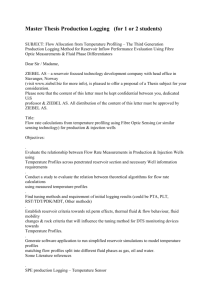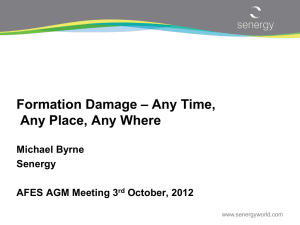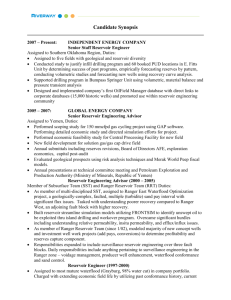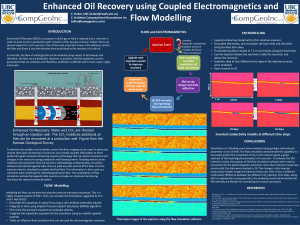Unit Wells
advertisement
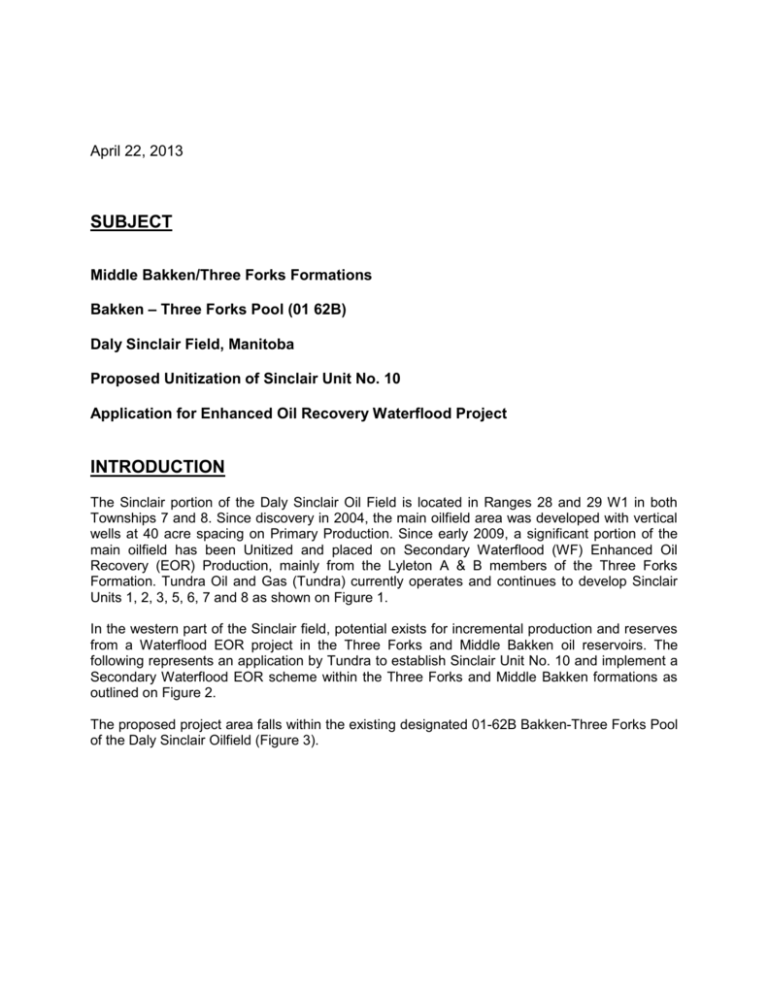
April 22, 2013 SUBJECT Middle Bakken/Three Forks Formations Bakken – Three Forks Pool (01 62B) Daly Sinclair Field, Manitoba Proposed Unitization of Sinclair Unit No. 10 Application for Enhanced Oil Recovery Waterflood Project INTRODUCTION The Sinclair portion of the Daly Sinclair Oil Field is located in Ranges 28 and 29 W1 in both Townships 7 and 8. Since discovery in 2004, the main oilfield area was developed with vertical wells at 40 acre spacing on Primary Production. Since early 2009, a significant portion of the main oilfield has been Unitized and placed on Secondary Waterflood (WF) Enhanced Oil Recovery (EOR) Production, mainly from the Lyleton A & B members of the Three Forks Formation. Tundra Oil and Gas (Tundra) currently operates and continues to develop Sinclair Units 1, 2, 3, 5, 6, 7 and 8 as shown on Figure 1. In the western part of the Sinclair field, potential exists for incremental production and reserves from a Waterflood EOR project in the Three Forks and Middle Bakken oil reservoirs. The following represents an application by Tundra to establish Sinclair Unit No. 10 and implement a Secondary Waterflood EOR scheme within the Three Forks and Middle Bakken formations as outlined on Figure 2. The proposed project area falls within the existing designated 01-62B Bakken-Three Forks Pool of the Daly Sinclair Oilfield (Figure 3). CONCLUSIONS 1. The proposed Sinclair Unit No. 10 will include 41 producing wells within 48 Legal Sub Divisions (LSD) of the Middle Bakken/Three Forks producing reservoir. The project is located west of the existing Sinclair Unit No. 1 (Figure 2). 2. Total Net Original Oil in Place (OOIP) in the project area has been calculated to be 15,262 thousand barrels (Mbbl) for an average of 318 net Mbbl OOIP per 40 acre LSD. 3. Cumulative production to the end of October 2012 from the 41 wells within the proposed Sinclair Unit No. 10 project area was 1,177 Mbbl of oil, and 447 Mbbl of water, representing a 7.7% Recovery Factor (RF) of the Net OOIP. 4. Estimated Ultimate Recovery (EUR) of Primary Proved Producing oil reserves in the proposed Unit 10 project area has been calculated to be 1,659 Mbbl, with 482 Mbbl remaining as of the end of October 2012. 5. Ultimate oil recovery of the proposed Unit 10 OOIP, under the current Primary Production method, is forecasted to be 10.8%. 6. Figure 4 shows the production from the proposed area which peaked in July 2006 at 968 bbl of oil per day (OPD). As of October 2012, production was 214 bbl OPD, 88 bbl of water per day (WPD) and a 41.0% watercut. 7. In July 2006, production averaged 33.4 bbl OPD per well. As of October 2012, average per well production has declined to 5.5 bbl OPD. Decline analysis of the group primary production data forecasts total oil to continue declining at an annual rate of approximately 17.85% in the project area. 8. Based on waterflood response in the adjacent main portion of the Sinclair field, the Three Forks and Middle Bakken Formations in the proposed project area are believed to be suitable reservoirs for WF EOR operations. 9. Estimated Ultimate Recovery (EUR) of proved oil reserves under Secondary WF EOR for the proposed Unit 10 has been calculated to be 2,996 Mbbl, with 1,819 Mbbl remaining. An incremental 1,337 Mbbl of proved oil reserves, or 8.8%, are forecasted to be recovered under the proposed Unitization and Secondary EOR production vs the existing Primary Production method. 10. Total RF under Secondary WF in the proposed Unit 10 is estimated to be 19.6%. 11. Horizontal injectors, with multi-stage hydraulic fractures, will be constructed between existing vertical producing wells, as shown in Figure 5, within the proposed Unit 10, to complete waterflood patterns with effective 20 acre spacing similar to that of Sinclair Unit No.1. DISCUSSION RESOURCE POTENTIAL IN PROPOSED SINCLAIR UNIT 10 The proposed Sinclair Unit No. 10 project area is located within Township 8, Range 29 W1 of the Daly Sinclair oil field. The proposed Unit 10 currently consists of 39 producing vertical wells and 2 producing horizontal wells within an area covering 3 sections (Figure 2). These sections include 6, 7 and 18-008-29W1. A project area well list complete with recent production statistics is attached as Appendix 20. Geology Stratigraphy The stratigraphy of the reservoir section in Unit 10 is shown on the structural cross section attached as Appendix 1. The line of section is shown on each of the maps attached as appendices and runs East-West approximately through the mid-point of Unit 10. The producing sequence in descending order consists of the Upper Bakken Shale, Middle Bakken Siltstone, Lyleton A Siltstone, the Red Shale Marker, Lyleton B Siltstone and the Torquay silty shale. The reservoir units are represented by the Middle Bakken, Lyleton A and Lyleton B Siltstones. The Upper Bakken Shale is a black, organic rich, platy shale which forms the top seal for the underlying Middle Bakken/Lyleton reservoirs. The Red Shale Marker is a very fine grained, dolomitic siltstone which effectively forms an aquitard between the Lyleton A and B reservoirs. The most easterly well, 13-08-008-29W1M well is located in Sinclair Unit 1. Correlation of this well with the wells in Sinclair Unit 10 (proposed) show that the same reservoir units are present in both units and are continuous and correlative between Units 1 and 10. Sedimentology The Middle Bakken reservoir consists of fine to coarse grained grey siltstone to fine sandstone which may be subdivided on the basis of lithologic characteristics into upper and lower units. The upper portion is very often heavily bioturbated and is generally non-reservoir. These bioturbated beds often contain an impoverished fauna consisting of well-worn brachiopod, coral and occasional crinoid fragments suggesting deposition in a marginal marine environment. The lower part of the Middle Bakken is generally finely laminated with alternating light and dark laminations with occasional bioturbation. Reservoir quality is highly variable within the Unit area. Over most of the area of Unit 10, the Middle Bakken is generally about 1-1.5 m thick, thickening up to greater than 2 m towards the eastern side of Unit 10 where the underlying Lyleton A is thinned by erosion (Appendix 2). The Lyleton A reservoir within the area of Unit 10 consists of buff to tan medium to coarse siltstone (occasionally fine sandstone) made up of quartz, feldspar and detrital dolomite with minor mica and clay mostly in the form of clay clasts or chips. Clays do not generally occur as pore filling material, but rather as discrete grains within the siltstone. The Upper part is generally well bedded and shows evidence of parallel lamination with occasional wind ripples. The coarser siltstones are interbedded with finer grained grey-green siltstone similar in composition to the reservoir siltstone, but generally with lower permeability (i.e. < 0.1 md). These finer grained siltstones show evidence of haloturbation producing smeared siltstone clasts floating in a fine grained grey-green siltstone matrix . The lower part of the Lyleton A generally shows a greater proportion of the grey-green fine-grained siltstone than the Upper and is generally a poorer reservoir. It also tends to exhibit greater amounts of haloturbation and pseudobreccia of siltstone clasts in a finer grained siltstone matrix. Because of the fine grained matrix in this pseudobreccia the connectivity between the clasts is much lower than the bedded siltstone and the Lower part of the Lyleton A is generally a poorer reservoir than the Upper part of the Lyleton A. Within the area of Unit 10 the Lyleton A is generally between 7 and 9 m thick with thickness variations the result of result of pre-Middle Bakken erosion removing the upper part of the Lyleton A (Appendix 3). The Red Shale Marker forms an aquitard between the Lyleton A and B reservoirs and consists of brick red dolomitic siltstone which is highly water soluble. The Red Shale Marker is generally between 3 and 4 m thick with the Unit area (Appendix 4). The Lyleton B in Unit 10 is similar to the Lyleton A, but with thinner beds of siltstone interbedded with darker grey-green very fine grained siltstone which is generally non-reservoir. The siltstone beds display variable reservoir quality, but the quality is generally less that that in the Lyleton A. The Lyleton B is generally between 4.5 and 6 m thick in Unit 10 and shows no evidence of erosional thinning within the Unit area (Appendix 5). The Torquay (Three Forks) forms the base of the Unit 10 reservoir sequence and is a brick red dolomitic fine to very fine siltstone similar to the Red Shale Marker that forms a good basal seal to the Lyleton B reservoir. Structure Structure contour maps are provided for the top of each major reservoir and non-reservoir unit. The structure within the area of Unit 10 generally consists of a gentle dip to the SE. A structurally low nose extending into the SW quarter of section 6 as shown on the Upper Bakken Structure map (Appendix 6) is the result of post Upper Bakken dissolution of the underlying Prairie Evaporites. Solution lows such as this are common in the Sinclair Field and represent potential hazards when drilling and completing horizontal injectors but do not appear to represent continuous barriers to lateral fluid flow within the reservoir as they do not appear to interrupt the lateral continuity of the reservoir beds (see cross section Appendix 1). This low is also evident on the Middle Bakken, Lyleton, Red Shale Marker, Lyleton B and Torquay (Three Forks) structure maps (Appendices 7 – 11) showing that the structural low post-dates all of the stratigraphic units in Unit 10. No direct evidence of natural faulting is noted from either proprietary seismic data or well/production data in the vicinity of the Unit 10 area, although the presence of such faults/fractures may be interpreted by the presence of salt dissolution lows. Whether or not such fracture systems conduits for vertical flow across the vertical flow barriers such as the Red Shale Marker is also indeterminate, although if such flow were possible it is highly likely the overlying Upper Bakken shale would have been compromised and the Sinclair hydrocarbon system would have been breached before the emplacement of the hydrocarbon charge which occurred much later than the salt dissolution. Any breaches in the Upper Bakken top seal must have been effectively sealed before this event and it is likely that any breaches in the Red Shale Marker would also have been sealed as well as there are hydrocarbons trapped in the Lyleton B reservoir at least as far downdip as in the Lyleton A and Middle Bakken reservoirs. Reservoir Continuity Lateral continuity of the reservoir units is an essential requirement of a successful waterflood and as demonstrated by the cross section (Appendix 1) and the isopach maps, the lateral continuity of the reservoir in Unit 10 is very good. None of the major reservoir units can be shown to depositionally thin laterally and where thinning does occur it can be demonstrated to be by pre-Middle Bakken erosion removing the upper part of the Lyleton A reservoir. Vertical continuity between the Middle Bakken and underlying Lyleton A reservoir is also good as there is no evidence of an intervening aquitard between these units. In fact it can be difficult even in core to pick the unconformity surface between these units. The vertical continuity between the Lyleton A and Lyleton B reservoirs is obviously non-existent due to the presence of the Red Shale Marker which represents an effective barrier to vertical flow (Appendix 1). However since the horizontal injector wells will be frac’d, vertical conductivity should be established at least in the area of the induced fractures. Reservoir Quality Porosity (Phi-h in por*m) and permeability (k-h in mD*m) maps for the three reservoir units are provided. These maps are generated using core data and are generated as follows. First the core is divided into the reservoir units present. This data is then subject to a 1.0 md cutoff on the permeability and intervals that meet or exceed this criteria are multiplied by the interval thickness and then summed to get the total value for the Phi-h or k-h for that particular reservoir unit. This cutoff is similar to the cutoff used by GLJ to generate the OOIP, but doesn’t utilize the 12 percent porosity cutoff since for core data the 1 md cutoff effectively removes all porosity less than 12 percent. As can be noted from the Phi-h and k-h maps the bulk of the reservoir in Unit 10 is contained in the Lyleton A section. It is important to note however that the 1.0 md cutoff effectively ignores a considerable pore volume with permeability between 0.2 and 0.99 md that may contain moveable oil. Maps of Phi-h and k-h for the Middle Bakken are included as Appendices 12 and 13, Lyleton A maps as Appendices 14 and 15 and Lyleton B maps for the project area as Appendices 16 and 17. Fluid Contacts The oil/water contact for the Middle Bakken and Lyleton reservoir is estimated from production to be at about -525 m subsea. In tight reservoirs such as these the transition zone could be considerable and the top of the transition zone is estimated to be at about -490 m subsea based on production and simulation studies of the reservoir. The top of the transition zone is indicated on the structure maps by the green coloured contour line. The postulated oil/water contact at 525 m subsea is below the lowest contour on any of the attached structure contour maps. OOIP Estimates Total volumetric OOIP for the Middle Bakken, Lyleton A, and Lyleton B members of the Three Forks formation, within the proposed Sinclair Unit No. 10 area, has been calculated to be 15,262 Mbbl. Table 2 within Appendix 18 outlines the proposed Unit 10 volumetric OOIP estimates on an individual LSD basis by formation. Average OOIP by individual LSD was determined to be 318 Mbbl, while the average per section is 5,087 Mbbl. OOIP values were calculated with 1.0 millidarcy (mD) permeability and 12% porosity net pay cutoffs. The OOIP values were determined independently by GLJ Petroleum Consultants of Calgary, and a copy of the report is included in Appendix 18. A listing of Middle Bakken/Three Forks formation rock and fluid properties used to characterize the reservoir are provided in Appendix 19. Historical Production A historical group production history plot for the proposed Sinclair Unit No. 10 is shown as Figure 4. Oil production commenced from the proposed Unit area in February 2003 and peaked during July 2006 at 918 bbl OPD. As of October 2012, production was 214 bbl OPD, 88 bbl WPD and a 41.0% watercut. From peak production in July 2006 to date, oil production is declining at annual rate of approximately 17.85% under the current Primary Production method. Cumulative production to the end October 2012 from the 41 wells within the proposed Sinclair Unit No. 10 project area was 1,177 Mbbl of oil, and 447 Mbbl of water, representing a 7.7% RF of the Net OOIP. Based on the geological description, primary production decline rate, and waterflood response in the adjacent main portion of the Sinclair field, the Three Forks and Middle Bakken Formations in the project area are believed to be suitable reservoirs for WF EOR operations. UNITIZATION Unitization and implementation of a Waterflood EOR project is forecasted to increase overall recovery of OOIP from the proposed project area. Unit Name Tundra proposes that the official name of the new Unit shall be Sinclair Unit No. 10. Unit Operator Tundra Oil and Gas Partnership (Tundra) will be the Operator of record for Sinclair Unit No. 10. Unitized Zone The Unitized zone(s) to be waterflooded in the Sinclair Unit No. 10 will be the Middle Bakken and Three Forks formations. Unit Wells The 41 wells to be included in the proposed Sinclair Unit No. 10 are outlined in Appendix 20. Unit Lands The Sinclair Unit No. 10 will consist of 4 Sections as follows: Section 6 of Township 8, Range 29, W1M Section 7 of Township 8, Range 29, W1M Section 18 of Township 8, Range 29, W1M Sinclair Unit No. 10 will consist of 48 LSDs. The lands included in the 40 acre tracts are outlined in Appendix 21. Tract Factors The proposed Sinclair Unit No. 10 will consist of 48 Tracts based on the 40 acre LSD’s containing the existing 39 vertical and 2 horizontal producing wells. Total oil production from the first 90 operating days (2,160 hours) for each LSD/well, and the OOIP by LSD/well, were used to determine the proposed Unit tract factors. Both 90 day production volume and OOIP each received an equal 50% weighting in calculating overall individual Tract Factors. Tract Factor calculations for all individual LSD’s based on the above methodology are outlined within Appendices 22 and 23. Working Interest Owners Appendix 21 also outlines the working interest (WI) for each recommended Tract within the proposed Sinclair Unit No. 10. Tundra Oil and Gas Partnership holds a 100.0% WI ownership in all the proposed Tracts. WATERFLOOD EOR DEVELOPMENT Waterflood EOR Development Technical Studies Due to the unconventional nature of the reservoir, Tundra has not been able to use reservoir simulation to accurately predict ultimate recoveries and sweep efficiency of the proposed waterflood. The lack of water breakthrough in our existing Sinclair Pilot Waterflood (WF) introduces an immense uncertainty in simulation modeling as it is very difficult to match a production profile that has not been observed. Although in an early stage, Tundra believes the existing Unit 1 WF Pilot area reservoir and waterflood response is a suitable analogy based upon the following: - - - - Both Sinclair Pilot WF and the proposed Unit 10 reservoirs have been developed with the same vertical producing well spacing and completion practices Proposed waterflood pattern development within Unit 10 is similar to the Sinclair Pilot WF with 6 to 8 existing vertical producing wells and a horizontal injector resulting in 20 acre spacing Since peak production in July 2006, average oil rate per producing well in the proposed Unit 10 has fallen dramatically (Figure 4) with an initial primary decline similar to the Section 4-8-29 Pilot WF wells primary decline (Figure 6) Permeability vs Porosity cross plots of all available core data for wells within the existing Sinclair Unit 1 (including the Pilot WF wells), Unit 3 and the proposed Sinclair Unit 10, indicate very similar reservoir rock characteristics as shown in Appendix 24 The proposed Unit 10 WF RF has been forecasted at 19.6% of OOIP which is below the 24.0 - 25.5% RF expected from the Sinclair WF Pilot. This is reasonable as this area of the Bakken-Three Forks Pool is of a slightly poorer quality than that of Unit 1. Proposed Unit 10 Reservoir Pressure Predictions No recent or representative pressure surveys are currently available from the vertical producing wells within the proposed Unit 10 project area. Tundra has however developed an empirical method of using observed pressure data from Sinclair Unit 1 to generate a regression analysis of cumulative fluid produced from a given pattern vs. measured pressure from the pattern injector. A pattern is considered as 6 or 8 vertical wells offsetting a horizontal injector with an allocation factor of 0.5 for fluid produced by the vertical wells. This analysis is used to directionally determine the expected range of pressure for the future injector wells using the cumulative production of that pattern. This method has been reasonably accurate in predicting expected pressures for injectors in Sinclair Units 2 and 3. Tundra has also attempted using more rigorous material balance method to predict the expected pressures but given the uncertainty of available PVT and formation compressibility data, this effort has not yielded any meaningful pressure estimate improvements over the empirical method to date. Tundra therefore believes the regression method is currently the best and most reliable tool available. Utilizing the method described, reservoir pressure in the proposed Unit 10 project area has been estimated to average 5000 kPa and range between 1200 – 7000 kPa. Actual reservoir pressures were measured at the adjacent Sinclair Unit 1 horizontal WIW’s in Sections 5, 8, and 17-8-29 W1M as follows (all referenced to Datum depth of -450 m subsea): 102/5-5-8-29 = 2649 kPaa 102/13-5-8-29 = 2077 kPaa 103/13-8-8-29 = 2367 kPaa 102/5-17-8-29 = 2591 kPaa 102/12-5-8-29 = 2196 kPaa 103/4-8-8-29 = 2291 kPaa 102/4-17-8-29 = 2585 kPaa 102/12-17-8-29 = 2636 kPaa Pre-Production of New Horizontal Injection Wells New horizontal injection wells will be constructed between the existing vertical producing wells as shown in Figure 5. Tundra proposes to construct 10 new horizontal water injection wells (WIW’s), which will result in an effective 20 acre line drive waterflood pattern within Unit 10. Primary production from the vertical wells in the proposed Unit 10 has declined significantly from peak rate indicating a need for secondary pressure support. However, through the process of developing similar waterfloods, Tundra has measured a significant and ever increasing incidence of variation in reservoir pressure depletion by the existing primary vertical producing wells. Placing new horizontal wells immediately on water injection in areas without significant reservoir pressure depletion has been particularly problematic in similar low permeability formations. As a result, the following conditions have been observed which Tundra believes negatively impact the ultimate total recovery factor of OOIP: - Lower initial and peak water injection rates Rapid increases in injection wellhead pressures to the maximum allowable Lower sustained water injection rates at maximum allowable pressure Lower monthly instantaneous and cumulative voidage replacement ratio Delayed secondary oil production response Secondary oil production response of lower magnitude Considering the expected reservoir pressures and reservoir lithology described, Tundra believes an initial period of producing all 10 new horizontal wells prior to placing them on permanent water injection is essential and all Unit mineral owners will benefit as follows: - Near term primary oil production increase Relatively higher injection rates following initial production due to oil and pressure depletion of the near horizontal well region Pre-producing injectors will yield more effective future injection wells as the fracture network and flowpaths within the stimulated region may be enhanced More efficient voidage replacement during first few years of the waterflood Secondary oil recovery factor may be higher than the current prediction if the primary to secondary recovery factor remains constant Primary Production Forecast The primary and secondary waterflood performance predictions for the proposed Unit 10 are based on recent internal engineering studies performed by the Tundra reservoir engineering group and external Consultants. Cumulative production in the Sinclair Unit No. 10 project area, to the end of October 2012, was 1,177 Mbbl of oil, and 447 Mbbl of water for a recovery factor of 7.7% of the calculated Net OOIP. The forecasted primary oil production profile, up to and including the pre-production period of the new horizontal wells for the Unit 10 project area is plotted as Figure 7. Ultimate Proved Producing oil reserves recovery for Unit 10 has been estimated to be 1,659 Mbbl, or a 10.8% Recovery Factor (RF) of OOIP. Remaining Producing Primary Reserves has been estimated to be 482 Mbbl. The expected production decline and forecasted cumulative oil recovery under continued Primary Production is shown in Figure 8. Pre-Production Schedule/Timing for Conversion of Horizontal Wells to Water Injection Tundra has designed the following horizontal well development schedule to allow for the most expeditious development of the waterflood within the proposed Unit 10: - - Immediate Unitization of the project area provides a mechanism for primary production allocation during the pre-production period, regardless of oil rate or time on production Unitization allows the Unit Operator to develop all 10 of the horizontal (future injection) wells in the most expeditious and operationally efficient manner Efficient execution of the new horizontal wells drilling and completions operations will ensure the first new horizontal wells within the Unit 10 boundary begin producing in Q4 of 2013 Calculate and/or obtain reservoir pressures and observe production rate profile characteristics on new horizontal and existing vertical producing wells during 2014 Expect to begin converting some horizontal wells to WIW service by late 2014 All horizontal wells are forecasted to be converted to WIW service by the middle of 2015 Secondary oil rate response at vertical producing wells is forecasted to begin within 2 – 4 months following conversion of the horizontal well to water injection service Criteria for Conversion to Water Injection Well Tundra will monitor the following parameters to assess the best timing for each individual horizontal well to be converted from primary production to water injection service. - Measured reservoir pressures at start of and/or through primary production Fluid production rates and any changes in decline rate Any observed production interference effects with adjacent vertical wells Pattern mass balance and/or oil recovery factor estimates Reservoir pressure relative to bubble point pressure Ten (10) horizontal wells are planned to be constructed for pre-production followed by permanent water injection service as shown in Figure 5. No existing vertical producer wells within the proposed Unit 10 project are planned for conversion to water injection, as oil production response is better with horizontal injectors than with four vertical injectors. The above schedule allows for the proposed Unit 10 project to be developed equitably, efficiently, and moves to project to the best condition for the start of waterflood as quickly as possible. It also provides the Unit Operator flexibility to manage the reservoir conditions and response to help ensure maximum ultimate recovery of OOIP. Secondary EOR Production Forecast The proposed project oil production profile under Secondary Waterflood has been developed based on the response observed to date in the Sinclair Pilot WF (Figure 6). The proposed Unit 10 Secondary Waterflood oil production forecast over time is plotted on Figure 7. Total Proved EOR recoverable reserves in the proposed Unit 10 project under Secondary WF has been estimated at 2,996 Mbbl (Figure 8), resulting in a 19.6% overall RF of calculated Net OOIP. An incremental 1,337 Mbbl of oil reserves are forecasted to be recovered under the proposed Unitization and Secondary EOR production scheme vs. the existing Primary Production method. Incremental Secondary RF is forecasted to be 8.8% of the calculated OOIP. Average incremental reserves recovery per project producing well is forecasted to be 32.6 Mbbl. Estimated Fracture Pressure Completion data from the existing producing wells within the project area indicate an actual fracture pressure gradient range of 19.0 to 20.9 kPa/m true vertical depth (TVD). Tundra expects the fracture gradient encountered during completion of the proposed horizontal injection well will be somewhat lower than these values due to expected reservoir pressure depletion. Waterflood Operating Strategy Water Source and Injection Wells The injection water for the proposed Sinclair Unit 10 water will be supplied from the existing Sinclair Units 1-3 source and injection water system. All existing injection water is obtained from the Lodgepole formation in the 102/16-32-7-29W1 licensed water source well. Lodgepole water from the 102/16-32 source well is pumped to the main Unit 1 Water Plant at 3-4-8-29W1, filtered, and pumped up to injection system pressure. A diagram of the Sinclair water injection system and new pipeline connection to the proposed Sinclair Unit No. 10 project area injection wells is shown as Figure 9. Produced water is not currently used for any water injection in the Tundra operated Sinclair Units and there are no current plans to use produced water as a source supply for Unit 10 injection. Since all producing Middle Bakken/Three Forks wells in the Daly Sinclair areas, whether vertical or horizontal, have been hydraulically fractured, produced waters from these wells are inherently a mixture of Three Forks and Bakken native sources. This mixture of produced waters has been extensively tested for compatibility with 102/16-32 source Lodgepole water, by a highly qualified third party, prior to implementation by Tundra in Sinclair Unit 1. All potential mixture ratios between the two waters, under a range of temperatures, have been simulated and evaluated for scaling and precipitate producing tendencies. Testing of multiple scale inhibitors has also been conducted and minimum inhibition concentration requirements for the source water volume determined. At present, continuous scale inhibitor application is maintained into the source water stream out of the Sinclair injection water facility. Review and monitoring of the source water scale inhibition system is also part of an existing routine maintenance program. Injection well rates vs. time plots are routinely monitored for evidence of any injection restriction due to scaling and Tundra sees no operational problems with the system design at this time. New water injection wells for the proposed Sinclair Unit 10 will be drilled, cleaned out, produced, and then configured for downhole injection as shown in Figure 10. The horizontal injection wells will be stimulated by multiple hydraulic fracture treatments to obtain suitable injection rates. Tundra has extensive experience with horizontal fracturing in the area, and all jobs are rigorously programmed and monitored during execution. This helps ensure optimum placement of each fracture stage to prevent, or minimize, the potential for out-of-zone fracture growth and thereby limit the potential for future out-of-zone injection. The new water injection wells will be placed on injection after the pre-production period and approval to inject. Wellhead injection pressures will be maintained below the least value of either: - the area specific known and calculated fracture gradient, or - the licensed surface injection Maximum Allowable Pressure (MOP) Tundra has a thorough understanding of area fracture gradients. A management program will be utilized to set and routinely review injection target rates and pressures vs. surface MOP and the known area formation fracture pressures. All new water injection wells will be surface equipped with injection volume metering and rate/pressure control (Figure 11). An operating procedure for monitoring water injection volumes and meter balancing will also be utilized to monitor the entire system measurement and integrity on a daily basis. The proposed Unit 10 horizontal water injection well rates are forecasted to average 95-220 bbl WPD based on expected reservoir conditions. Reservoir Pressure Management during Waterflood Tundra expects to inject water for a minimum 2-4 year period to re-pressurize the reservoir due to cumulative primary production voidage and pressure depletion. Initial monthly Voidage Replacement Ratio (VRR) is expected to be approximately 1.25 to 2.00 within the patterns during the fill up period. As the cumulative VRR approaches 1, target reservoir operating pressure for waterflood operations will be 75-90% of original reservoir pressure. Waterflood Surveillance and Optimization Unit 10 EOR response and waterflood surveillance will consist of the following: - Regular production well rate and WCT testing Daily water injection rate and pressure monitoring vs target Water injection rate/pressure/time vs. cumulative injection plot Reservoir pressure surveys as required to establish pressure trends Pattern VRR Potential use of chemical tracers to track water injector/producer responses Use of some or all of: Water Oil Ratio (WOR) trends, Log WOR vs Cum Oil, Hydrocarbon Pore Volumes Injected, Conformance Plots The above surveillance methods will provide an ever increasing understanding of reservoir performance, and provide data to continually control and optimize the Unit 10 waterflood operation. Controlling the waterflood operation will significantly reduce or eliminate the potential for out-of-zone injection, undesired channeling or water breakthrough, or out-of-Unit migration. The monitoring and surveillance will also provide early indicators of any such issues so that waterflood operations may be altered to maximize ultimate secondary reserves recovery from the proposed Unit 10. On Going Reservoir Pressure Surveys For each proposed horizontal injection well, a measured reservoir pressure will be obtained prior to water injection. Tundra expects useful reservoir pressure data may be obtained from existing vertical wells within the project area after WF start up. These pressures will be reported within the Annual Progress Reports for Sinclair Unit No. 10 as per Section 73 of the Drilling and Production Regulation. Economic Limits Under the current Primary recovery method, existing wells within the proposed Sinclair Unit No. 10 will be deemed uneconomic when the net oil rate and net oil price revenue stream becomes less than the current producing operating costs. With any positive oil production response under the proposed Secondary recovery method, the economic limit will be significantly pushed out into the future. The actual economic cut off point will then again be a function of net oil price, the magnitude and duration of production rate response to the waterflood, and then current operating costs. Waterflood projects generally become uneconomic to operate when Water Oil Ratios (WOR’s) exceed 100. Water Injection Facilities The Sinclair Unit No. 10 waterflood operation will utilize the existing Tundra operated source well supply and water plant (WP) facilities located at 3-4-8-29 W1M. A complete description of all planned system design and operational practices to prevent corrosion related failures is shown in Figure 12. Notification of Mineral and Surface Rights Owners . Tundra is in the process of notifying all mineral rights and surface rights owners of this proposed EOR project and formation of Sinclair Unit No. 10. Copies of the Notices, and proof of service, to all surface rights owners will be forwarded to the Petroleum Branch, when available, to complete the Unit 10 Application. Sinclair No. 10 Unitization, and execution of the formal Unit 10 Agreement by affected Mineral Owners, is expected before the end of March 2013. Copies of same will be forwarded to the Petroleum Branch, when available, to complete the Unit 10 Application. TUNDRA OIL & GAS PARTNERSHIP Calgary, AB
